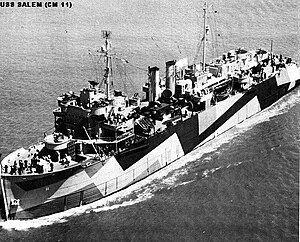
USS Pitt (APA-223/LPA-223) was a Haskell-class attack transport in service with the United States Navy from 1944 to 1947. She was scrapped in 1980.

USS Terror (CM-5) was a fleet minelayer of the United States Navy, the only minelayer of the fleet built specifically for and retained for minelaying during World War II.
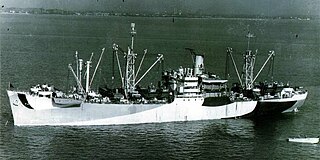
USS Suffolk (AKA-69) was a Tolland-class attack cargo ship in service with the United States Navy from 1944 to 1946. She was sold into commercial service and was scrapped in 1971.
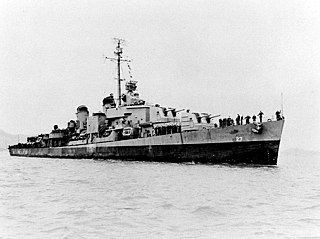
USS Adams (DM-27) was a destroyer minelayer in the United States Navy. She was named for Lieutenant, junior grade Samuel Adams. The other two USS Adams that have existed were named after the second president.

USS Thomas E. Fraser (DD-736/DM-24) was a Robert H. Smith-class destroyer minelayer in the United States Navy.

USS Tolman (DD-740/DM-28/MMD-28) was a Robert H. Smith-class destroyer minelayer in the United States Navy.

USS Shelter (AM-301) was an Admirable-class minesweeper built for the United States Navy during World War II. After service in the Pacific during World War II, Shelter was decommissioned in June 1946 and placed in reserve. In January 1964, she was transferred to South Vietnam for service in the Republic of Vietnam Navy as RVNS Chi Linh (HQ-11). She remained in South Vietnamese service until the collapse of that country in 1975. Chi Linh was one of several ships that fled from South Vietnam to the Philippines. She was then commissioned into the Philippine Navy in April 1976 as RPS Datu Tupas (PS-18), named after a chieftain of Cebu. The ship's fate is not reported in secondary sources.

USS Egeria (ARL-8) was one of 39 Achelous-class landing craft repair ships built for the United States Navy during World War II. Named for Egeria, she was the only U.S. Naval vessel to bear the name.
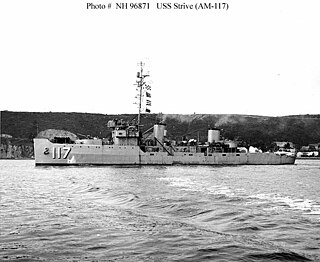
USS Strive (AM-117) was an Auk-class minesweeper acquired by the United States Navy for the dangerous task of removing mines from minefields laid in the water to prevent ships from passing.

USS Keokuk (AN-5/CM-8/CMc-6/AKN-4) was a mine and net laying ship of the United States Navy during World War II.
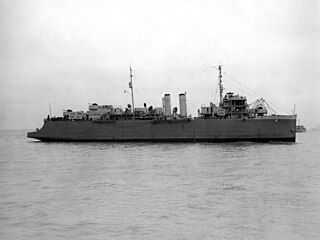
USS Weehawken (CM-12) was originally SS Estrada Palma – a car ferry built in 1920 by William Cramp & Sons of Philadelphia. It was acquired by the United States Navy on 15 June 1942; renamed Weehawken on 18 July 1942; converted to a minelayer by the Bethlehem Steel Co. at Hoboken, New Jersey; designated CM-12; and commissioned on 30 September 1942.
USS Tekesta (AT-93) was Navajo-class fleet tug built during World War II for the United States Navy. Shortly after being built, it was crewed by trained Navy personnel and sent into the Pacific Ocean to provide tug service to damaged ships in battle areas. For successfully performing this dangerous work, she was awarded four battle stars by the war's end.

USS Sederstrom (DE-31) was a Evarts-class destroyer escort of the United States Navy during World War II. She was promptly sent to the Pacific Ocean to escort convoys and to protect other ships from Japanese planes and submarines. Her assignments took her from one battle area to another, but she was fortunate in remaining almost unscathed by the end of the war. For her efforts in battle areas, she was awarded five battle stars by war's end.

The second USS Tisdale (DE-33) was an Evarts-class destroyer escort of the United States Navy during World War II. She was promptly sent off into the Pacific Ocean to protect convoys and other ships from Japanese submarines and fighter aircraft. She performed dangerous work in numerous battle areas, and was awarded four battle stars.

USS Alkes (AK-110) was a Crater-class cargo ship commissioned by the US Navy for service in World War II, named after Alkes, a star in the Crater constellation. She was responsible for delivering troops, goods and equipment to locations in the war zone.

USS Matar (AK-119) was a Crater-class cargo ship, converted from a Liberty Ship, commissioned by the US Navy for service in World War II. She was first named after Napoleon B. Broward, an American river pilot, captain, and politician; he was elected as the 19th Governor of the US state of Florida. She was renamed and commissioned after Matar, a binary star in the constellation of Pegasus. She was responsible for delivering troops, goods and equipment to locations in the war zone.

USS Adria (AF-30) was an Adria-class stores ship in service with the United States Navy from 1944 to 1954. She was scrapped in 1977.

USS Terebinth (AN-59) – laid down as USS Balm (YN-78) – was a Ailanthus-class net laying ship which served with the U.S. Navy during World War II. Terebinth served in the Pacific Ocean theatre of operations and was awarded a battle star for her participation in the Okinawa campaign. Post-war she was decommissioned and sold.
USS Arapaho (AT-68/ATF-68) was a Navajo-class fleet ocean tug which served the U.S. Navy during World War II with her towing services. She was assigned initially to support the U.S. Atlantic Fleet, and was eventually assigned to support Allied forces in the war zones of the Pacific Ocean, resulting in her crew returning home after the war with four battle stars to their credit.
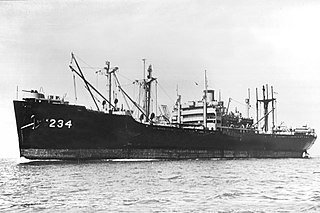
USS Bucyrus Victory (AK-234) was a Boulder Victory-class cargo ship acquired by the U.S. Navy during World War II. She served in the Pacific Ocean theatre of operations through the end of the war, earning one battle star, and then returned to the United States for disposal.
